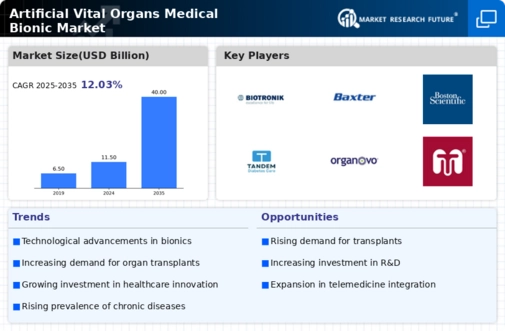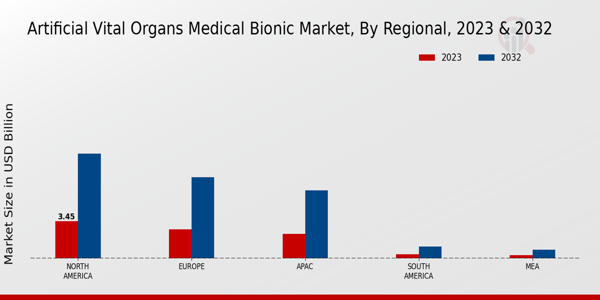Aging Population
The Global Artificial Vital Organs Medical Bionic Market Industry is also driven by the aging population, which is more susceptible to various health issues, including organ failure. As life expectancy increases, the demand for artificial organs is likely to rise. Older adults often require advanced medical interventions, including bionic solutions, to maintain their quality of life. This demographic shift suggests a robust market growth trajectory, with a projected compound annual growth rate (CAGR) of 12.04% from 2025 to 2035, indicating a sustained demand for artificial vital organs.
Market Growth Projections
Technological Advancements
The Global Artificial Vital Organs Medical Bionic Market Industry is propelled by rapid technological advancements in bionic devices. Innovations in materials science and engineering have led to the development of more efficient and biocompatible artificial organs. For instance, the integration of artificial intelligence in bionic limbs enhances functionality and user experience. These advancements not only improve the quality of life for patients but also expand the market's potential. As of 2024, the market is valued at 11.5 USD Billion, indicating a growing acceptance and reliance on these technologies in healthcare.
Rising Awareness and Acceptance
The Global Artificial Vital Organs Medical Bionic Market Industry is experiencing growth due to rising awareness and acceptance of bionic technologies among patients and healthcare providers. Educational campaigns and success stories of bionic organ recipients are helping to demystify these technologies, leading to increased patient confidence. As more individuals become aware of the benefits of artificial organs, the demand for these solutions is likely to rise. This shift in perception is crucial for market expansion, as it encourages healthcare professionals to recommend bionic solutions as viable treatment options.
Government Initiatives and Funding
Government initiatives and funding play a crucial role in the Global Artificial Vital Organs Medical Bionic Market Industry. Many governments are investing in research and development to advance bionic technologies, recognizing their potential to improve healthcare outcomes. For example, funding programs aimed at supporting innovative medical technologies are becoming more prevalent. These initiatives not only foster innovation but also encourage collaboration between public and private sectors, ultimately enhancing the market landscape. Such support is vital for accelerating the development and adoption of artificial organs in clinical settings.
Increasing Prevalence of Chronic Diseases
The Global Artificial Vital Organs Medical Bionic Market Industry is significantly influenced by the rising prevalence of chronic diseases such as diabetes and heart disease. These conditions often lead to organ failure, necessitating the use of artificial organs for treatment. According to health statistics, the number of patients requiring organ transplants is on the rise, creating a substantial demand for bionic solutions. This trend is expected to contribute to the market's growth, with projections indicating a market size of 40.0 USD Billion by 2035, reflecting the urgent need for innovative medical solutions.














